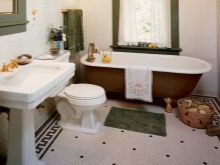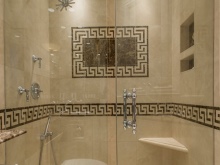Greek Bathroom Style
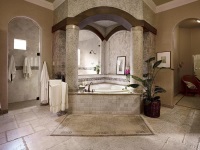
When we talk about the Greek style in the interior or in clothes, we usually have in mind not modern Greece, but the period in the history of this state, which is called antiquity. During the several thousand years of its existence, the ancient Greek civilization did an incredible amount to develop science and art. In ancient Greece, culture and knowledge were of the utmost importance. All modern science is based on the works of ancient Greek philosophers and mathematicians. And the works of sculptors, architects and artists of Ancient Greece are still considered to be examples of classical art.
The ancient Greeks, like no other people in human history, knew how to appreciate beauty. Beauty for them was harmony and order. The search for harmony, the desire to express the unity of form and content - this is what determined the development of ancient Greek art.
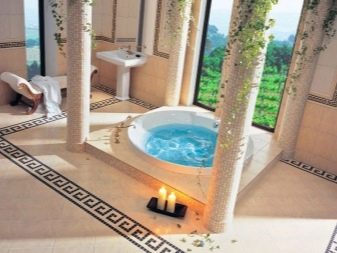
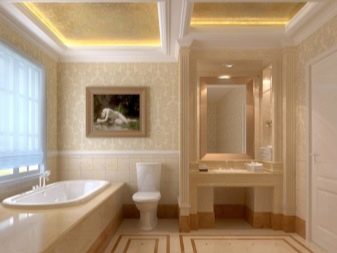
Interest in the achievements of the ancient Greek civilization revived towards the end of the last millennium. It was reflected in the formation of such styles as classicism and baroque. The influence of ancient Greek culture was very strong not only in theater, literature and painting, but also in architecture and design. In modern interiors, the Greek theme also remains popular. Today we will tell you about creating a Greek interior in the bathroom.
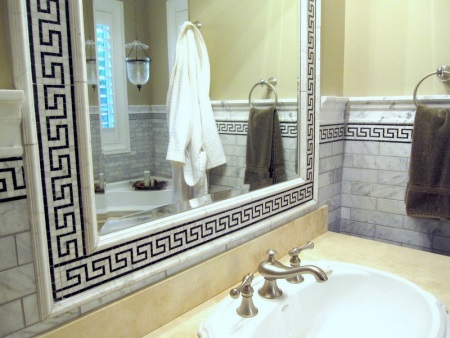
Features of the style
Quite often the Greek style is confused with the wealth and luxury of the Roman direction in design. And this is natural, because these two civilizations are very closely related to each other and have many similar features. But we shouldn't identify them: the Greek style is characterized by restraint and elegance, while the Roman style is more "pompous".
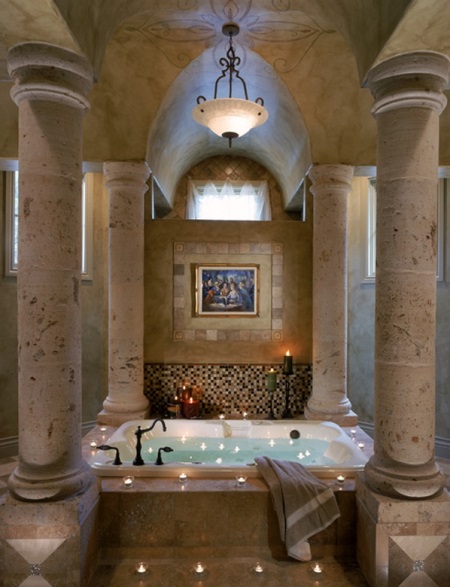
So, the main features of the interior in the Greek style:
- spacious rooms with high ceilings and large windows;
- The frequent use of columns;
- The use of national Greek ornaments - meander loops as a decorative element;
- stucco on ceilings, columns and other structures;
- themed murals on the walls;
- pastel color palette;
- a minimum of glitter, including gilding;
- surface finish with natural or artificial marble tiles;
- the use of mostly natural materials;
- copies of works of art by Ancient Greek masters as decorative elements.
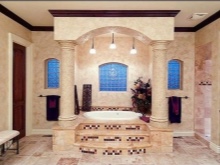
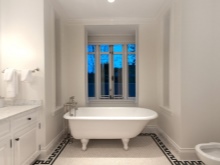
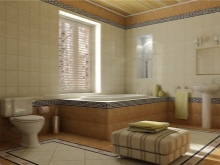
Who is suitable?
The Greek style is one of the classic directions in design. It can be called a universal style, because the calmness and nobility of this style is suitable for a variety of premises and is liked by a variety of people. However, there are categories of people who will especially like the Greek interior:
- Owners of spacious apartments in "stalinkas" or new buildings, as well as those who live in country houses. In order for the interior in the Greek style to look properly, you need a large area and high ceilings. Only in this case the arched vaults and marble columns will look harmonious.
- Connoisseurs of the classics. If you are far from modern culture, the latest trends in apartment design (such as loft or fusion) are unlikely to please you. In this case, the simplicity and harmony of the Greek style, in which there is nothing superfluous and every thing has its place, is your choice.
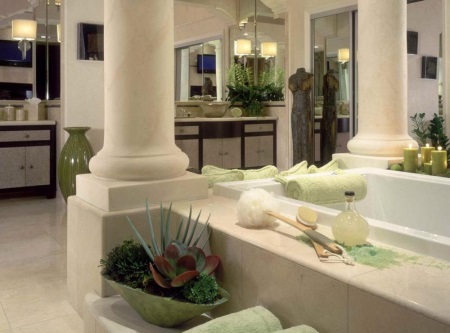
Colors
Like any other room decorated in the Greek style, the bathroom should be done in light colors. Since it is assumed that all surfaces in the room are lined with marble (even if in fact it is just an imitation of natural stone), the dominant color in the interior will be white and tones close to it: milky, creamy, light beige, light lemon. Allowed as a light touch of blueness - after all, absolutely white marble in nature is practically never met.
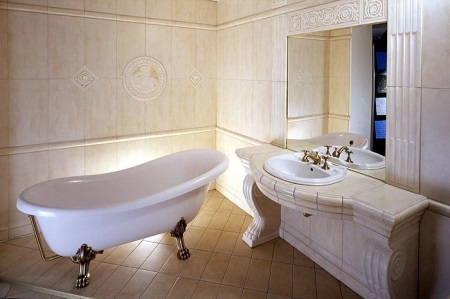
If you want to bring a little bright colors into a classic Greek interior, you can bring it closer to a more modern version of the Greek direction in design - the Mediterranean style. It involves the use of bright, saturated, but not provocative colors - turquoise, coral, yellow, olive, green.
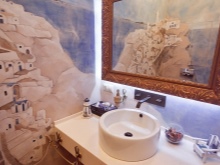
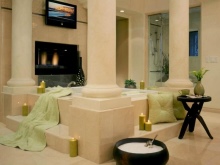
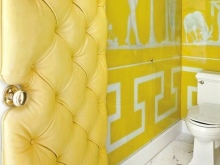
Finishing materials
The ancient Greek rulers and noble citizens actively used marble for finishing their homes. They used it for walls revetment, floor paving, columns and bas-reliefs. Today, to purchase natural marble in sufficient quantity to decorate even a small room such as a bathroom, will cost a pretty penny. Not everyone can afford such a luxury, so as an alternative to natural marble we recommend you to use ceramic tiles.
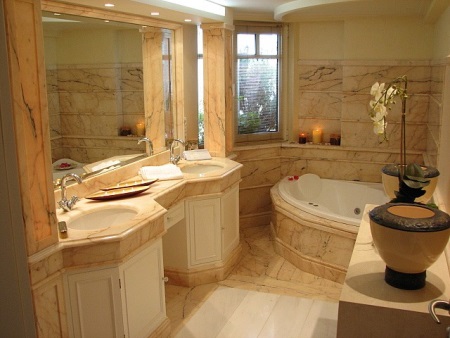
Modern production technologies make it possible to produce porcelain stoneware and tile tiles imitating natural marble. The composition of finishing materials can include real marble chips, which makes the stone texture even more realistic.
For finishing walls and floors, choose large tiles in light colors. Ceramic mosaics and borders can be used as original decorative elements. Meander pattern edging (a continuous ornament of straight lines and angles, imitating sea waves) can be placed both on the edge of the floor, and on the walls. Almost all stores that sell finishing materials offer a collection of tiles in the Greek style.
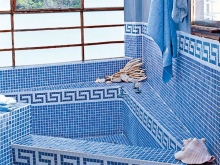
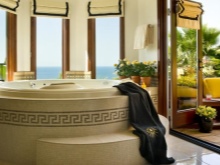
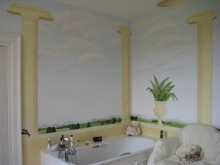
Illumination
Ideally, the main source of light in a Greek bathroom should be a big window, overlooking the sea coast. But if you are not the lucky owner of a private house in one of the seaside cities, to translate this design solution into reality will be very problematic.
If you can not provide natural light in the bathroom, then you need to properly organize the artificial light. The light in the Greek bathroom should be as much as possible, and it must penetrate into all corners of the room. But, at the same time, the light should not be too bright and hurt your eyes.

A classic chandelier can be used as the main source of light - but only if the height of the ceilings allows it. Complement the ceiling lamp can be a pair of sconces from the same collection. In the bathroom with low ceilings it is better to use spotlights. In this case, try to choose models without noticeable chrome elements - much better will look fixtures in the body under the bronze, brass or gold.

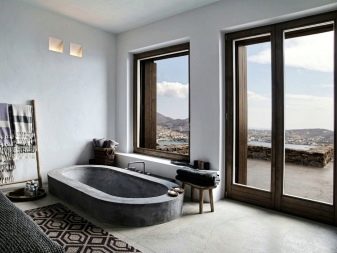
Decor and accessories
Since the people who inhabited ancient Greece had a great love for fine art, objects of this very art should be the main decoration of a bathroom decorated in the Greek style. Murals depicting scenes from myths and legends are a typical element of decor for a room in the Greek style. The only problem is that painting on wet plaster in conditions of high humidity, under the influence of hot steam and water droplets will not last long. Therefore it is better to replace it with a tile panel on the appropriate subject.
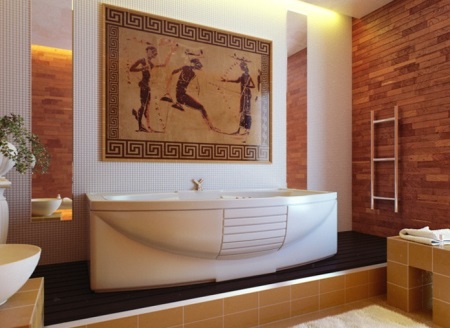
But porcelain and marble perfectly tolerate moisture, so all kinds of figurines, vases and amphorae can be safely used as accessories for the bathroom in the Greek style. Miniature sculptures can depict ancient Greek gods, mythological creatures, heroes or animals.
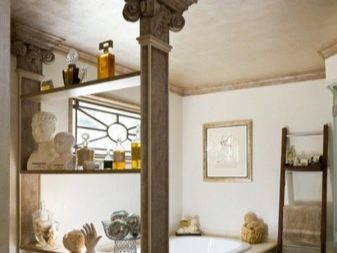
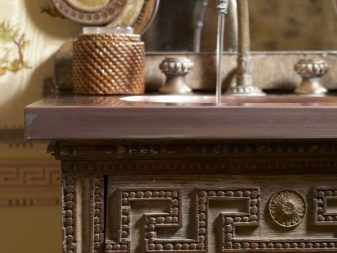

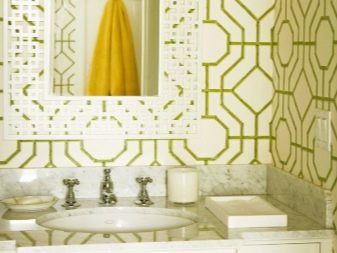
Design Features
Elegance and simplicity is the most appropriate definition for the Greek style. This also applies to the choice of furniture for the bathroom. There should not be too much furniture, but if the size of the room allows, you can complement the interior with a couch on curved legs or a classic armchair. The best solution will be wooden furniture with light fabric upholstery.
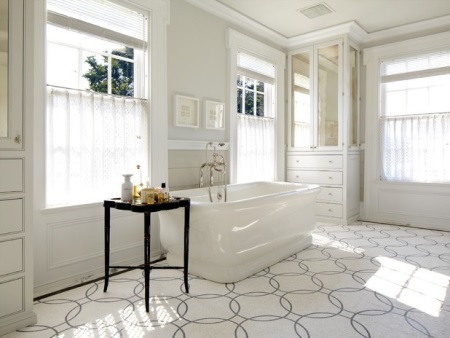
Plumbing in the Greek bathroom should be in line with all other elements of the interior - the correct form, discreet, but in a noble performance. Very effectively and to the point will look a large bath made of natural or artificial marble. The font must have the right form - round, oval or square. If you chose a small bathtub of cast iron or acrylic, we recommend installing it on decorative legs with bronze or gold spraying.
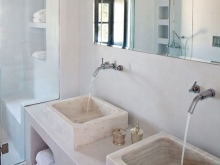
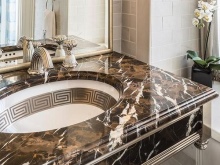
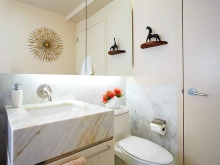
Creating a unique interior
- Greek ornaments can not only decorate the floor and walls, but also be present in the decoration of furniture and bathroom fixtures.
- A large mirror in a simple openwork frame must be in the bathroom, arranged in the Greek style.
- If the room has a window, it is necessary to decorate it with an airy, translucent curtain, which on a warm summer day will be slightly developed by a breeze.
- When decorating the bathroom in the Greek style, you should try to observe the principles of symmetry and harmony. So, the font itself can become a compositional center, around which the rest of the interior will line up.
